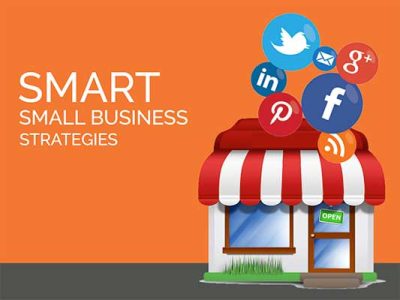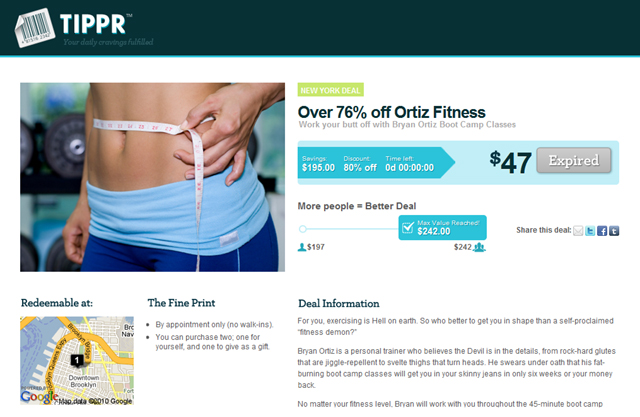
 There are a lot of buzz words on the social web these days: group buying, location-based services, SEO, just to name a few. Sorting through the information to figure out what’s just hype and what your business can actually work with can be a daunting task — it uses up resources, including time and money, and sometimes leads you and your social media strategy in the wrong direction.
There are a lot of buzz words on the social web these days: group buying, location-based services, SEO, just to name a few. Sorting through the information to figure out what’s just hype and what your business can actually work with can be a daunting task — it uses up resources, including time and money, and sometimes leads you and your social media strategy in the wrong direction.
With technology adoption rates skyrocketing among small businesses and small business social media success stories popping up all around the web, it’s likely that more SMBs will be joining the social revolution in the near future.
But how does your business decide which social venues are right for your company, customer base and goals? It’s a tough call, but it all boils down to doing your research and creating a clear-cut strategy.
While serving on a panel at a recent social media training session for small business owners, I received a number of questions on how to grow a business using social media and other free or low-cost tools on the web.
Five particular questions stood out as being highly relevant and oh-so fresh, so I would like to share them with the greater community of small business owners looking to promote their companies via social media. Add your own thoughts and questions on these topics in the comments below.
1. Is group buying right for my business?

One of the latest trends in social media and online shopping is group buying, in which consumers act en masse to get great deals on products and services. Sites like Groupon, LivingSocial, Tippr and BuyWithMehave all seen big successes, but should small businesses jump in on the action? In order to evaluate the opportunity here, your business must weigh the pros and cons.
On the positive side, group buying sites can generate a lump sum of revenue very quickly. Most deals last no longer than a day, and after the deal has ended, your company is cut a quick check.
Secondly, because of the nature of group buying sites, you get a mass of new customers signed up to try out your product or service. That can’t be bad if you’re offering something of great value to them.
But it’s not all good news for small businesses. Most group buying sites take up to 50% of the revenue that a deal brings in. For example, let’s say you own a gym and an average gym membership is $800 per year. You decide to set up a deal on Groupon for 50% off an annual gym membership, for a total cost of $400 to the customer. Because Groupon takes 50% of the cut, you are left with $200 of revenue from one gym membership. So, in the end, you’ve actually forfeited 75% of the retail membership price.
You should also be aware of your brand’s image when dealing with coupon-centric marketing opportunities like group buying. Make sure that a site’s audience matches your own target audience before signing up for a deal. There isn’t a lot of research on who uses group buying sites, but it’s safe to say that people who love great deals are drawn to them. That doesn’t mean that these consumers won’t pay the full price next time, but that’s always a possibility to be aware of.
If your goal is to facilitate customer trials or to generate quick cash (without concern for selling highly discounted business), group buying is a great place to start. But if you’re worried about maintaining a luxury brand status or high profit margins on products sold, it may not be a good idea for your brand.
2. Without a location, how can I use location-based marketing?
Most location-based services, like Foursquare, Gowalla and SCVNGR, are built to help users find and explore the best spots around them. Businesses with permanent addresses, such as stores and restaurants, take advantage of these services by offering venue-specific deals. When users open a business’s page to check in on their mobile apps, they usually see an alert for a special in that location, such as a discount or freebie.
Finding interesting ways to utilize location-based services can be a challenge for businesses without permanent addresses, such as online services and media companies. But there are still opportunities — creativity is key.
If you produce a lot of content online, via a website or blog, you should consider leaving insider tips at other venues related to your content or industry. For example, Mashable leaves tips relevant to the tech community, such as where to find free wi-fi and industry meetups.
Another way to utilize location-based marketing is to get involved with other mobile apps or sites that serve ads to users in certain locations. Brightkite, for example, can serve ads based on location, time and behavior.
3. How do I start a blog if I’m not tech savvy?
You don’t have to be a computer science whiz to start a blog. Try starting off with a simple platform, and if that doesn’t work, you can always hire a web designer or developer to help you.
Start with a simple platform: Building a website or blog can be quite intimidating, and content management systems like WordPress, Drupal and ExpressionEngine can be overkill for many people. If you’re just looking to create a few simple pages, such as an about page and a contact page, and then update with blog posts, try Tumblr. There are quite a few themes for small business needs, and the interface is very easy to use. After you create your page, updating it with content is just a matter of inputting the blog post, choosing a few descriptive tags and publishing.
WordPress.com (which shouldn’t be confused with WordPress.org) and Blogger are other entry-level options. They both provide free themes that can be customized, and while the WordPress and Blogger dashboards may look a bit more complicated than the Tumblr dashboard, a quick tutorial should have you up to speed.
If you’re looking for a step up, look into a few other lightweight CMS solutions, such as MojoMotor, CushyCMS, GetSimple CMS, Simple CMS and Perch.
Hire a web designer or developer: If you are still confused about how to get your blog up and running, considering hiring a web designer or developer. Sometimes, it’s just best to leave these things up to the professionals.
Once you get started, check out these corporate blogging tips and learn a few lessons from some of the best corporate blogs out there.
4. Why isn’t my business’s social media following growing?
There are a ton of reasons why your current social media strategy may not be serving you well. Here are a few possibilities — take a look and see if anything sounds familiar to your business:
- You update your page too often or too little. There isn’t an exact science to figuring out when you should send out a tweet, post to Facebook or update other social sites, but you should figure out some general guidelines that fit for your company. Try to update your social sites at least a few times a week and daily if possible. If you notice that customers are complaining about frequency, adjust accordingly.
- Your messaging is too promotional. Your followers and subscribers do not want to be “sold” or bombarded with marketing messages. Your audience is used to being barraged with marketing messages from all angles — in their homes, at work, on the street. The last thing they want is to opt in to another marketing message from a brand that they trust and enjoy. Keep the promotions to a minimum and try to provide meaningful and useful content to your followers.
- You don’t offer value to your followers. Also related to messaging is the possible lack of value propositions. Set up a clear idea of how you will use each social site and what type of value you’ll be providing. Then, communicate it clearly. Most people follow brands on social sites to get deals and discounts. Make sure you understand your consumers’ motivations for following you and respond accordingly.
- You aren’t promoting your social profiles enough. “If you build it, they will come.” That old adage may be true for baseball fields, but it’s not true for social media profiles. You need to get the word out that you’re using certain social platforms. While some dedicated fans may find you via search or by perusing the web, others need a bit of encouragement. Utilize your website, businessplace, flyers and even business cards to get the word out.
- Your need to interact more. Social media is, well, meant to be social. If you aren’t responding to questions or engaging with your followers, chances are they think you’re just a blank-faced marketer or an automated feed updating your company’s social sites. Give your social profiles a face by engaging with the community.
5. How do I optimize my business’s social media pages for search?
Search engine optimizations is all about content. For starters, make sure that your social profiles and their URLs are named after your business. If your company is called Moozey Market, for example, you should name your profiles accordingly (not Moozey’s or M. Market, but Moozey Market) and make sure the URLs are also appropriately designated: facebook.com/moozeymarket, twitter.com/moozeymarket, moozeymarket.tumblr.com, and so on. If your desired URL is not available, feel free to modify, but keep it as close to the original name as possible, without including misspellings or strange abbreviations.
After you have your names and URLs down, make sure you fill out all of the available information — bio, location, mission, products, and so on. Be sure to add links to all of your other social pages to increase inbound links for each of them. Inbound links, or backlinks, help search engines understand the popularity of your website, blog or social profile. The more backlinks, the higher your page will rank in search results. On your business’s Facebook page, for example, list your Twitter, YouTube and Flickr accounts to ensure that users know you’re on those platforms and to increase your inbound links.
The last step is to continuously update your pages with content that is relevant to your industry. Think about the type of information that your target audience is seeking. If you are a baker, for example, you could maintain a steady flow of recipes, baking tips and local restaurant recommendations. It is likely that someone looking for baking recommendations may be interested in learning more about your bakery.
All of this information ultimately helps your social profiles rank higher in search results.
These five questions are great primers for small businesses that are starting or revamping their social media strategies. Add your thoughts and questions on these topics in the comments below.
